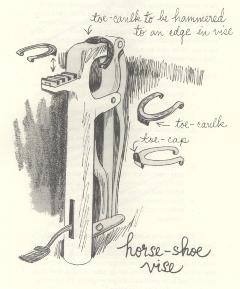This is a quirky little book that has numerous problems that I blame on the publisher.
While the book has some redeeming points the editing is miserable.
The book has no continuity of time. The preface states that the smith died in 1984 and then the following page opens with
"A decade ago I came upon this smithy and its staunch master forger within. . "
The author then states that he started documenting the shop several years later, in 1977.
This is all very confusing in a book first published and copyright 2009. An editor should have sorted this out.
Other oddities include extraneous local history that only locals would understand plus rambling free verse by the author.
Those pages need replacement with hard local history rather than anecdotal stories about irrelevant subjects.
In numerous places an editor should have said, "more research", or "tie this togeher", and also done some cutting.
The book DOES illustrate the life of Oliver Hamelin and his shop.
There are numerous photos and sketches.
However, the photos are typical of those taken in a dark blacksmith shop.
The drawings and writing show little interest in the details of the tools.
Much is made of the smith making axe handles but the process is incomplete.
I had many questions and there were no answers.
The author does do a good job of capturing the character of the shop.
The damp dankness, soot covered beams and typical disorganization of old one-man shops.
Some tools and methods are illustrated but not to the degree of completeness stated by the publishing house.

The plan and photos of the shop illustrate how few tools rural blacksmiths often had for the amount of work they produced.
The major machine in this shop was an old hand crank drill press.
Besides anvil and forge there was a caulking vise as the primary forge vise and a small leg vise on a bench.
A primitive wood bed shop built lathe and a similar grinding bench finished off the blacksmith shop equipment
and there was a typical small collection of small tools.
There may have been a band saw in the wood shed as evidenced by the many axe handles made but it is not mentioned.
This is a piece of local history that should be preserved. Every Canadian library should have a copy.
However, it is one of those "something is better than nothing" books without global appeal.
Last Blacksmith
of Apple Hill
Oliver Hamelin and his Shop
82 Pages, B&W, 8 photos and illustrations 7-1/2" x 10-1/2"
Color slip cover
Book Review by Jock Dempsey
This is a quirky little book that has numerous problems that I blame on the publisher. While the book has some redeeming points the editing is miserable. The book has no continuity of time. The preface states that the smith died in 1984 and then the following page opens with "A decade ago I came upon this smithy and its staunch master forger within. . " The author then states that he started documenting the shop several years later, in 1977. This is all very confusing in a book first published and copyright 2009. An editor should have sorted this out.Other oddities include extraneous local history that only locals would understand plus rambling free verse by the author. Those pages need replacement with hard local history rather than anecdotal stories about irrelevant subjects. In numerous places an editor should have said, "more research", or "tie this togeher", and also done some cutting.
The book DOES illustrate the life of Oliver Hamelin and his shop. There are numerous photos and sketches. However, the photos are typical of those taken in a dark blacksmith shop. The drawings and writing show little interest in the details of the tools. Much is made of the smith making axe handles but the process is incomplete. I had many questions and there were no answers.
The author does do a good job of capturing the character of the shop. The damp dankness, soot covered beams and typical disorganization of old one-man shops. Some tools and methods are illustrated but not to the degree of completeness stated by the publishing house.
The plan and photos of the shop illustrate how few tools rural blacksmiths often had for the amount of work they produced. The major machine in this shop was an old hand crank drill press.
Besides anvil and forge there was a caulking vise as the primary forge vise and a small leg vise on a bench. A primitive wood bed shop built lathe and a similar grinding bench finished off the blacksmith shop equipment and there was a typical small collection of small tools. There may have been a band saw in the wood shed as evidenced by the many axe handles made but it is not mentioned.
This is a piece of local history that should be preserved. Every Canadian library should have a copy. However, it is one of those "something is better than nothing" books without global appeal.
Published by:
Shoreline Press
Ste-Anne-de-Bellevue, QC
CANADA
ISBN 978-1-896754-75-8
$19.95 CAD